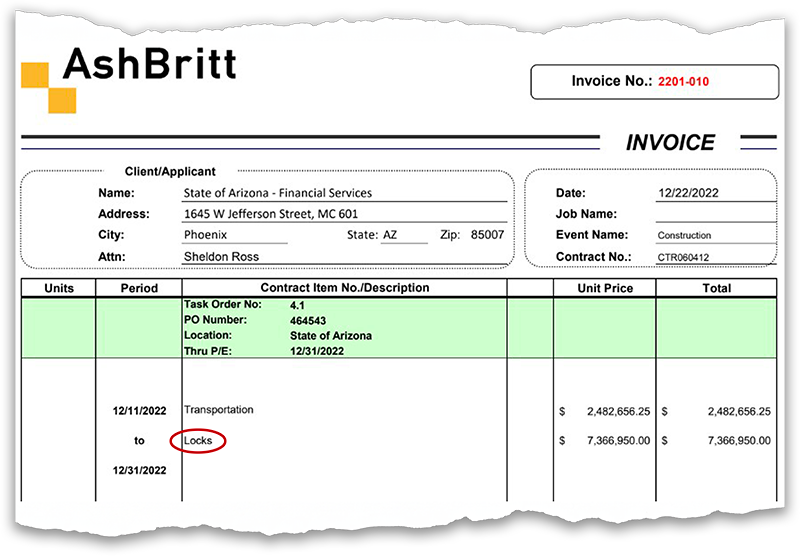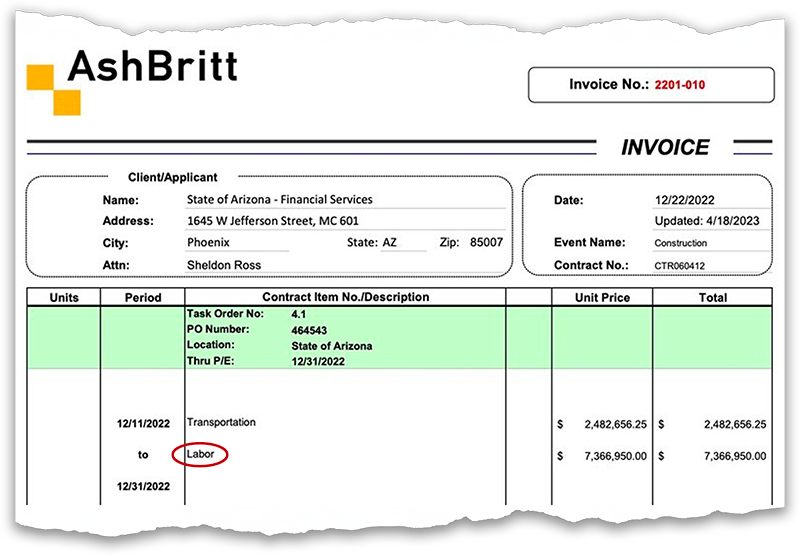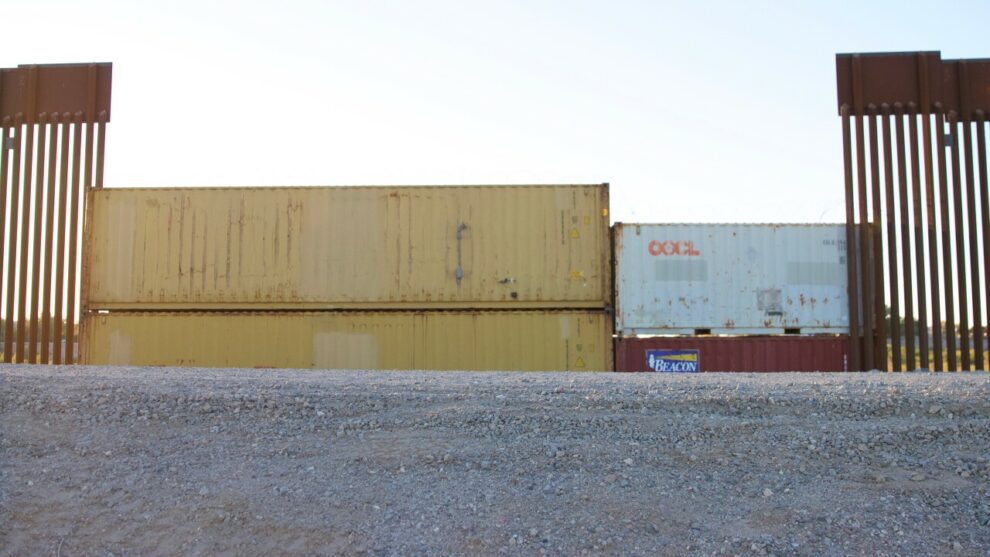Just a few years ago, Arizona’s Department of Emergency and Military Affairs (DEMA) was counted among the state’s smaller agencies, known for preparing Arizonans for summer monsoons.
That changed in 2021, when then-Gov. Doug Ducey declared a state of emergency over immigration and put DEMA in charge of what was to become a half a billion dollars to secure the state’s border with Mexico.
Nearly two-thirds of the money was intended for construction of a barrier at strategic points along the border. The solution the administration settled on was unusual: empty shipping containers stacked one on top of the other and locked end to end.
The sudden responsibility strained DEMA’s small staff, according to legislative emails, and in September, Darlene Quihuis, the department’s assistant director, told the governor’s council on human trafficking that DEMA was unprepared to manage so much money.
“I can tell you how to repair a bridge, not lay a southern border wall and make it stay,” she said.
Her words foreshadowed what was to come. The border wall that DEMA oversaw did not stay and was not finished; it came down after the Ducey administration, faced with a federal lawsuit, agreed to remove it.
In its wake, the wall left scars across the southern landscape and cost Arizona taxpayers nearly $200 million.
An investigation into the justification and contract for the wall by the Howard Center for Investigative Journalism uncovered more than just taxpayer dollars down the drain.
The investigation reviewed hundreds of pages of legislative records, payments on the Arizona Financial Transparency Portal, contracts and invoices. It found that:
- State officials used emergency powers to sign a no-bid contract to build the wall, circumventing competitive procurement laws, even though a barrier along the border was under consideration for a year and could have been handled competitively.
- DEMA contracted with the builder before assessing in detail how much the wall would cost. The first hard figures didn’t come until two months after the contract was signed. They were double DEMA’s preliminary estimate.
- The Ducey administration’s decision to build the wall on federal land over the federal government’s objections proved especially costly. The state paid the contractor millions of dollars to idle its equipment and workers during the legal standoff and other work stoppages, records show.
Gaps in the records and errors on some invoices also raised questions about DEMA’s oversight of AshBritt Inc., the Florida contractor that was ultimately paid $194.7 million to put the wall up, and then take it down.
DEMA officials corrected three different contract records after the Howard Center asked them about questionable entries or inconsistencies.
For example, AshBritt invoiced – and the state paid – $7.37 million for “locks,” a material cost that had never exceeded $125,025 on previous invoices.

When Howard Center reporters questioned DEMA about the expense months later, Judy Kioski, a DEMA spokesperson, wrote in an email that the description of “locks” was a typo and should have read “labor.”
After communicating with AshBritt about the charge, DEMA provided a corrected invoice to reporters.

In another error, an invoice referred to work done between “9/1/22” and “9/31/22” even though September only has 30 days.
DEMA officials also removed a $4 million entry from the state’s transparency portal after reporters questioned why there was no supporting invoice for the payment.
Kioski said in an email the payment was a duplicate that should not have been posted to the portal and that the Department of Administration is investigating how the error occurred.
Gerardo Castillo, president of AshBritt Management & Logistics, the AshBritt division that built the wall, declined all comments about the contract in a telephone call and referred questions to DEMA.
Over the course of the Howard Center’s months-long investigation, Kioski ignored the center’s requests for interviews and never spoke to reporters by phone or in person.
The political groundwork for the wall
From the beginning to the end of the border wall saga, there were partisan divisions over the Ducey administration’s claim that there was an immigration crisis in southern Arizona.
Ducey declared a state of emergency at the border in April 2021 three months after President Biden took office, claiming that immigrants were overwhelming the resources of four border counties and two adjacent ones.
None of the counties – Yuma, Pima, Santa Cruz, Cochise, Maricopa and Pinal – declared a state of emergency on their own prior to Ducey’s declaration.
Anti-immigration messaging was central to the campaigns of many Arizona Republican incumbents and office seekers in 2022. In the legislature, lawmakers put tax dollars behind the administration’s emergency rhetoric with a whopping $544.2 million appropriation for “border security” in fiscal year 2023.
The administration’s claims of a border crisis were also used to secure an “emergency procurement authorization” in May 2022 that allowed the state to sign a sole-source contract with AshBritt to build the wall.
But legislative records show that construction of a border wall was contemplated at least a year earlier.

In 2021, the legislature passed – and Ducey signed – a law creating the Border Security Fund, seeding it with $55 million for DEMA. The act listed seven specific uses for the fund.
Number five on the list was “administering and managing the construction and maintenance of a physical border fence.”
David Blackledge, an attorney with Davis Miles McGuire Gardner, formerly developed contracts with the federal government. He said that in his experience a year appeared to have been enough time for a large contract such as the border wall to have been sourced competitively.
State Sen. John Kavanagh, R-Fountain Hills, sponsored the appropriations bill to fund the shipping-container wall in 2022 as a House member. In an interview with the Howard Center, Kavanagh said that he was not involved in the contracting process and was unaware the state intended to seek an emergency procurement authorization.
Kavanagh said the idea for a wall made out of empty shipping containers came from the governor’s office. He also said that his initial appropriation of $150 million for the wall was based on what he thought the state budget could deliver, not on how many miles of wall the money could buy.
By the time the appropriations bill was sent to Ducey, GOP lawmakers increased the $150 million Kavanagh initially proposed for the wall to $335 million. Not a single Democratic lawmaker voted for the bill.
AshBritt was the only company considered for the work, according to an email from Megan Rose, spokesperson for the Arizona Department of Administration (DOA), the state’s contracting authority.
“DEMA was directed to expedite this activity for the protection of life and safety,” Rose wrote.
Rose said the state was impressed with AshBritt’s work in Texas, but she did not know what work in Texas made AshBritt stand out.
Texas contracted AshBritt for help with the state’s COVID-19 response in 2021 – but not to build either of the state’s temporary shipping container walls in El Paso and Eagle Pass, according to invoices obtained through an open records request.
The cost doubles
The DOA approved the emergency procurement authorization May 19, 2022. The four-page document provided a barebones description of the project, saying that AshBritt would survey the border area and close gaps with long shipping containers.
The state estimated the cost of the project at $65 million.
AshBritt’s contract with the state, signed two months later, did not reference that estimate – nor any other.
While the contract included a pricing sheet for labor crews, equipment and containers, the cost of the project depended on how many labor crews the company used, how many days they worked and, crucially, how much wall they were to build.
The first hard estimates of those costs didn’t come until the end of July, two months after the contract was signed.
A contract amendment, the first of six, detailed work in Yuma, Nogales and Cochise County. The cost? $123.6 million – almost twice the state’s estimate four months earlier.
Labor costs were the single biggest line item. The initial contract said AshBritt would deploy a minimum of three labor crews for the work. Each crew plus equipment cost nearly $100,000 for just one day, according to the pricing sheet included in the contract.
Instead of three crews, however, eight were to be deployed at two of the sites listed in the contract amendment.
The amendment also revealed a glaring omission from the original contract. While AshBritt’s pricing sheet included a unit price for containers, it did not include pricing for transporting them.
Each container measured 20 to 40 feet in length and weighed several tons, so the cost of moving so many to the border was bound to be high.
It was.
In the first contract amendment, AshBritt calculated transportation costs alone at nearly $16 million, roughly four-fifths the cost of the containers themselves.
By the end of the project, when AshBritt had transported the containers to the border, and then away again, transportation costs associated with the work amounted to $42 million, more than a fifth of the project’s entire expense, according to invoices.
The wall goes up
AshBritt’s work began the first week of August in Yuma. The company estimated the cost at $6 million, according to its first invoice.
But that figure increased to $10.25 million just three weeks later in the first contract amendment, which added more work.
After Yuma, AshBritt intended to put up containers in Nogales at a cost of $15 million, according to its contract, but shifted operations to Cochise County instead.

The company never built any wall in Santa Cruz County, where Nogales is located, but billed the state a total of $41.7 million for work around Nogales, according to the invoices.
When asked about the Nogales expenses, Kioski said in an email that Nogales was used as a staging area for the shipping container wall, and that the costs were related to that work.
As AshBritt worked, the standoff over the legality of the wall intensified between the Ducey and Biden administrations.
When the legislature debated the $335 million to be set aside for the border wall, GOP lawmakers repeatedly insisted that the wall would not be built on federal land.
By mid-August, however, after the funds had been allocated and AshBritt began work, Ducey signed an executive order directing the construction of the wall “regardless of location.” The next day, work began to place containers on federal and tribal land.
In mid-October, the federal Bureau of Reclamation asked the state to remove the containers AshBritt put up in Yuma County because they had not been authorized to be built there.
The Ducey administration sued the federal government a week later, arguing that the federal government did not have exclusive rights to decide what happened on the 60-foot-wide portion of land running along the U.S.-Mexico Border.
The dispute, along with protesters showing up at the border, caused stoppages in work, according to AshBritt’s documentation.
But while work stopped, payments to the company didn’t.
Contract amendments between the company and the state made provisions for AshBritt to be paid if its workers were idle or had to be moved in and out of job sites during pauses.
The first pause DEMA ordered came after the Biden administration’s letter to the state requesting that the containers in Yuma be removed. The stoppage resulted in a $5.5 million payment to AshBritt, most of it for standby time and moving work crews and equipment from the job site.
Over the course of the contract, the state paid AshBritt at least $33 million to move its workers from one place to another and to pay them a reduced rate when they were idle, according to invoices.
‘A very expensive advertisement’
AshBritt continued to buy shipping containers and bill the state for the labor to put them up while the Ducey administration’s lawsuit against the Biden administration was pending.
On Dec. 14, the Biden administration filed suit to have the containers taken down, alleging Arizona was trespassing on federal land.

The two sides reached an agreement on Dec. 21. Two days later, the state signed contract amendments with AshBritt to take down the walls in Yuma and Cochise counties and to transport the containers to state-owned prison complexes less than 50 miles from the border.
Taxpayers paid AshBritt $64.3 million for the deconstruction work and to transport containers not yet used for the wall to the prisons, according to invoices.
The transportation costs associated with removing the containers from the border were more than twice what AshBritt charged to transport them in from ports in either California or Texas, according to the invoices.
Kioski, DEMA’s spokesperson, said in an email costs for removing the containers were more expensive because the transportation included “movement from multiple locations; transporting containers to staging areas, placement, removal from staging areas and movement to their current location for disposition with the Arizona Department of Administration.”
In the end, only about four to four and a half miles of wall were built, less than half of what was originally planned, at a cost of roughly $40 to $50 million per mile, including the cost to take the containers away.
The half-mile section in Yuma stood for four months. The 3.7-mile Cochise section stood for less time.
The project was not a total loss. The state now owns about 2,100 shipping containers parked in southern Arizona, according to DEMA. The market value of used containers ranges from $2,000 to $4,000 each depending on condition, according to multiple online retailers.
Gov. Katie Hobbs’ administration has no definitive plans for them but has suggested they might be converted into affordable housing.
On Feb. 7, AshBritt submitted its final invoice and fulfilled a contract stipulation that it credit an unspecified amount back to the state.
The invoice totaled $20.5 million. The credit back to the state was $150,000.
State Rep. Athena Salman D-Tempe, a member of the House Appropriations Committee, told the Howard Center in an interview that the nearly $200 million spent on the wall could have been better spent on other needs such as housing, health care and education.
“Unfortunately, all these crucial areas have just been ignored and neglected,” she said. “Instead we just see money going towards pet projects and publicity stunts, just so that they can prove a political point.”
But Kavanagh blamed the federal government for the money wasted on the project.
“If they hadn’t have objected, we’d have bought a wall, we’d have more border wall that we need than we have today, since it was removed,” the state senator said.
Kavanagh said the wall’s dismantling sent “a message to the entire country that the federal government is not serious about border security.”
Pausing a moment, he added, “A very expensive advertisement.”










